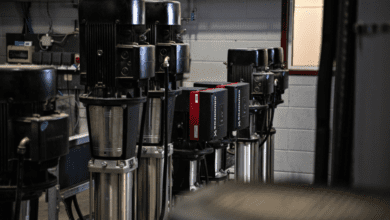Keep your dewatering project afloat

To choose the right floating pump station for a dewatering project, it is important to understand the factors which affect its environment, deployment, operation and maintenance. Dewatering specialist, Weir, outlines seven things which need to be considered when choosing a dewatering barge.
Three elements will determine the type of barge suitable for any given application: the hydraulic requirements of dewatering, the physical conditions on site and the bathymetry of the water the barge will be deployed on.
PHYSICAL CONDITIONS
While some mines enjoy reasonable weather year-round and are readily accessible by heavy transport, it’s not uncommon for the climate to significantly affect the installation and operation of waterborne dewatering equipment.
Unsurprisingly, the most common issues come from areas where temperatures regularly fall below 0°C for sustained periods. Not only can the resulting ice interfere with the dewatering itself, but surface ice can cause substantial damage over time to barges and pontoons, necessitating a de-icing solution to keep an area around the barge fluid.
Weir Minerals’ Multiflo barges employ de-icing systems to manage temperatures as low as -50°C, which have been tested in the trying conditions of the Canadian tundra, and other arctic-like environments. They allow for worry-free, year-round operation when combined with heat tracing, self-draining pipes, and other freeze-prevention systems.
Areas prone to seasonal flooding or extended rainfall experience drastic changes in water level, which have to be accounted for in the mooring or anchoring system used, access to the barge, and bottom-out protection (filled foam used to protect against hull breach) for the pump.
For many remote sites, a seasonal or permanent lack of readily accessible roads designed for heavy-load traffic will affect which barges can be deployed. Weir Minerals’ engineered-to-order dewatering pump systems have been deployed in a number of hard-to-access regions around the world and can accommodate sites requiring airlift or traffic over ice roads.
Many other site conditions have to be accounted for when designing a barge system; wind, snow, and seismic loading all affect the buoyancy and stability of the barge.
POND BATHYMETRY
A pond bathymetry survey should be conducted to map the body of water’s geotechnical data. This hydro-acoustic survey produces maps showing the water depths based on location. This information is crucial to analyse wave formation, which is used in the marine analysis to simulate wave loading on the barge structure, pipeline, and access walkways.
These factors will determine where the barge should ideally be placed and how much mooring or anchoring it will require to stay in place. This requirement can be substantial, with some projects requiring hundreds of tonnes of anchoring to prevent high winds from forcing the barge to break free and collide with land or other equipment, or even capsizing.
DEWATERING AND HYDRAULIC REQUIREMENTS
The parameters of the pumps needed for dewatering naturally determine the style of barge suitable to carry it. Once a pump has been selected, its type (vertical, submersible, horizontal), physical size, weight and geometry will determine how it can be safely supported on the barge.
Larger horizontal pumps typically require barges like the WEIR Multiflo steel hull barges, while smaller vertical pumps can be mounted on polythene or fibreglass barges. In addition to the pump size, the number of pumps on one barge system also plays a major factor in barge hull determination, with steel hull barges typically able to support more than one pump.
The nature of the substance being pumped also plays an important role, especially in brine or acidic applications. Due to the corrosive effects, the barge hulls and frames must be fabricated from special materials or protected with special coatings or anti-corrosion systems such as cathodic protection.
A number of secondary factors, such as the provisioning of input power, pump maintenance strategies and barge access, are key to the ongoing efficiency of the dewatering operation.
ACCESS TO BARGE
In most cases, a floating walkway is a preferred method of accessing a barge – combining economic efficiency with constant personnel access to the platform. It also simplifies power distribution, as cable trays can carry electrical and control cables.
For platforms which require direct vehicle access, a suspension bridge or gangway between the barge and the shore is the most elegant solution, although they typically aren’t economically practical over long distances, particularly in areas prone to snowfall. For areas where neither of these are practical, marine access involving boats or hovercraft is generally used to access the barge.
MAINTENANCE
The ideal maintenance strategy generally depends on the type of dewatering being performed – while all pumps require regular maintenance, those deployed in clear-water applications generally have more flexibility in their planning than tailings and slurry dewatering, where maintenance is always a core part of the conversation.
Larger, monolithic or pumphouse style barges with space for a monorail or crane within the pumphouse allow pumps to be refurbished and repaired on the barge itself, while other barges need to be pulled to shore for the pumps to be extracted.
POWER
The provisioning of power is another key factor in designing a dewatering solution, particularly for sites which are too remote for standard electrical access.
For most applications, a shore-based electrical genset is the ideal solution, as it simplifies management and operates more efficiently than a diesel engine.
PORTABILITY
The last key decision point is how portable the barge needs to be. Will one barge be dewatering in multiple locations over its lifespan or deployed in a particularly remote location?
If it’s being reused in multiple locations, does it need to be draggable between ponds?
For larger installations, it’s important to consider if the operation is likely to be scaled up or down further on, which could require modular barges or leaving extra space for additional pumps to be added down the track.







